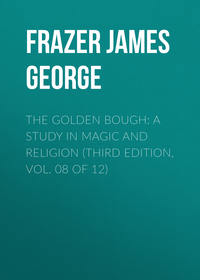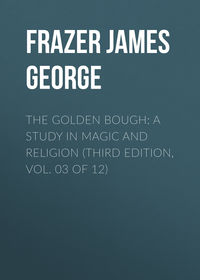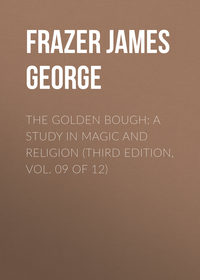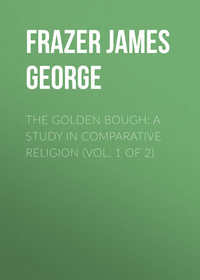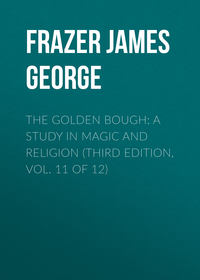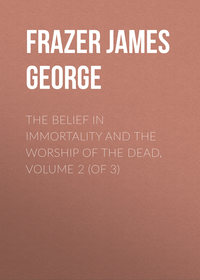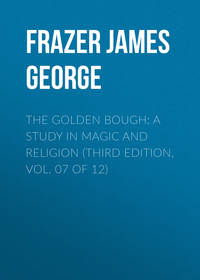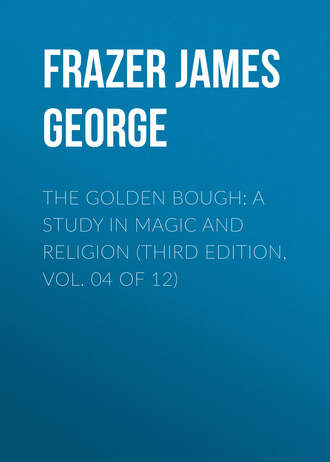 полная версия
полная версияThe Golden Bough: A Study in Magic and Religion (Third Edition, Vol. 04 of 12)
Custom of Thalavettiparothiamin Malabar. Custom of the Sultans of Java.
When kings were bound to suffer death, whether at their own hands or at the hands of others, on the expiration of a fixed term of years, it was natural that they should seek to delegate the painful duty, along with some of the privileges of sovereignty, to a substitute who should suffer vicariously in their stead. This expedient appears to have been resorted to by some of the princes of Malabar. Thus we are informed by a native authority on that country that “in some places all powers both executive and judicial were delegated for a fixed period to natives by the sovereign. This institution was styled Thalavettiparothiam or authority obtained by decapitation. Parothiam is the name of a supreme authority of those days. The name of the office is still preserved in the Cochin state, where the village headman is called a Parathiakaran. This Thalavettiparothiam was a terrible but interesting institution. It was an office tenable for five years during which its bearer was invested with supreme despotic powers within his jurisdiction. On the expiry of the five years the man's head was cut off and thrown up in the air amongst a large concourse of villagers, each of whom vied with the other in trying to catch it in its course down. He who succeeded was nominated to the post for the next five years.”103 A similar delegation of the duty of dying for his country was perhaps practised by the Sultans of Java. At least such a custom would explain a strange scene which was witnessed at the court of one of these sultans by the famous traveller Ibn Batuta, a native of Tangier, who visited the East Indies in the first half of the fourteenth century. He says: “During my audience with the Sultan I saw a man who held in his hand a knife like that used by a grape-gleaner. He placed it on his own neck and spoke for a long time in a language which I did not understand. After that he seized the knife with both hands at once and cut his throat. His head fell to the ground, so sharp was the blade and so great the force with which he used it. I remained dumbfoundered at his behaviour, but the Sultan said to me, ‘Does any one do like that in your country?’ I answered, ‘Never did I see such a thing.’ He smiled and replied, ‘These people are our slaves, and they kill themselves for love of us.’ Then he commanded that they should take away him who had slain himself and should burn him. The Sultan's officers, the grandees, the troops, and the common people attended the cremation. The sovereign assigned a liberal pension to the children of the deceased, to his wife, and to his brothers; and they were highly honoured because of his conduct. A person, who was present at the audience when the event I have described took place, informed me that the speech made by the man who sacrificed himself set forth his devotion to the monarch. He said that he wished to immolate himself out of affection for the sovereign, as his father had done for love of the prince's father, and as his grandfather had done out of regard for the prince's grandfather.”104 We may conjecture that formerly the sultans of Java, like the kings of Quilacare and Calicut, were bound to cut their own throats at the end of a fixed term of years, but that at a later time they deputed the painful, though glorious, duty of dying for their country to the members of a certain family, who received by way of recompense ample provision during their life and a handsome funeral at death.
Religious suicides in India.
A similar mode of religious suicide seems to have been often adopted in India, especially in Malabar, during the Middle Ages. Thus we are told by Friar Jordanus that in the Greater India, by which he seems to mean Malabar and the neighbouring regions, many sacrifice themselves to the idols. When they are sick or involved in misfortune, they vow themselves to the idol in case they are delivered. Then, when they have recovered, they fatten themselves for one or two years; and when another festival comes round, they cover themselves with flowers, crown themselves with white garlands, and go singing and playing before the idol, when it is carried through the land. There, after they have shown off a great deal, they take a sword with two handles, like those used in currying leather, put it to the back of their neck, and cutting strongly with both hands sever their heads from their bodies before the idol.105 Again, Nicolo Conti, who travelled in the East in the early part of the fifteenth century, informs us that in the city of Cambaita “many present themselves who have determined upon self immolation, having on their neck a broad circular piece of iron, the fore part of which is round and the hinder part extremely sharp. A chain attached to the fore part hangs suspended upon the breast, into which the victims, sitting down with their legs drawn up and their neck bent, insert their feet. Then, on the speaker pronouncing certain words, they suddenly stretch out their legs, and at the same time drawing up their neck, cut off their own head, yielding up their lives as a sacrifice to their idols. These men are regarded as saints.”106 Among the Jaintias or Syntengs, a Khasi tribe of Assam, human sacrifices used to be annually offered on the Sandhi day in the month of Ashwin. Persons often came forward voluntarily and presented themselves as victims. This they generally did by appearing before the Rajah on the last day of Shravan and declaring that the goddess had called them to herself. After due enquiry, if the would-be victim were found suitable, it was customary for the Rajah to present him with a golden anklet and to give him permission to live as he chose and to do what he liked, the royal treasury undertaking to pay compensation for any damage he might do in the exercise of his remarkable privileges. But the enjoyment of these privileges was very short. On the day appointed the voluntary victim, after bathing and purifying himself, was dressed in new attire, daubed with red sandal-wood and vermilion, and bedecked with garlands. Thus arrayed, he sat for a time in meditation and prayer on a dais in front of the goddess; then he made a sign with his finger, and the executioner, after uttering the usual formulas, cut off his head, which was thereafter laid before the goddess on a golden plate. The lungs were cooked and eaten by such Kandra Yogis as were present, and it is said that the royal family partook of a small quantity of rice cooked in the blood of the victim. The ceremony was usually witnessed by crowds of spectators who assembled from all parts of the neighbouring hills. When the supply of voluntary victims fell short, emissaries were sent out to kidnap strangers from other territories, and it was the practice of such man-hunts that led to the annexation of the Jaintia country by the British.107
Pretence of putting the king's proxy to death. Man killed at the installation of a king of Cassange.
When once kings, who had hitherto been bound to die a violent death at the end of a term of years, conceived the happy thought of dying by deputy in the persons of others, they would very naturally put it in practice; and accordingly we need not wonder at finding so popular an expedient, or traces of it, in many lands. Thus, for example, the Bhuiyas are an aboriginal race of north-eastern India, and one of their chief seats is Keonjhur. At the installation of a Rajah of Keonjhur a ceremony is observed which has been described as follows by an English officer who witnessed it: “Then the sword, a very rusty old weapon, is placed in the Raja's hands, and one of the Bhuiyas, named Anand Kopat, comes before him, and kneeling sideways, the Raja touches him on the neck as if about to strike off his head, and it is said that in former days there was no fiction in this part of the ceremony. The family of the Kopat hold their lands on the condition that the victim when required shall be produced. Anand, however, hurriedly arose after the accolade and disappeared. He must not be seen for three days; then he presents himself again to the Raja as miraculously restored to life.”108 Here the custom of putting the king's proxy to death has dwindled, probably under English influence, to a mere pretence; but elsewhere it survives, or survived till recent times, in full force. Cassange, a native state in the interior of Angola, is ruled by a king, who bears the title of Jaga. When a king is about to be installed in office, some of the chiefs are despatched to find a human victim, who may not be related by blood or marriage to the new monarch. When he comes to the king's camp, the victim is provided with everything he requires, and all his orders are obeyed as promptly as those of the sovereign. On the day of the ceremony the king takes his seat on a perforated iron stool, his chiefs, councillors, and the rest of the people forming a great circle round about him. Behind the king sits his principal wife, together with all his concubines. An iron gong, with two small bells attached to it, is then struck by an official, who continues to ring the bells during the ceremony. The victim is then introduced and placed in front of the king, but with his back towards him. Armed with a scimitar the king then cuts open the man's back, extracts his heart, and having taken a bite out of it, spits it out and gives it to be burned. The councillors meantime hold the victim's body so that the blood from the wound spouts against the king's breast and belly, and, pouring through the hole in the iron stool, is collected by the chiefs in their hands, who rub their breasts and beards with it, while they shout, “Great is the king and the rites of the state!” After that the corpse is skinned, cut up, and cooked with the flesh of an ox, a dog, a hen, and some other animals. The meal thus prepared is served first to the king, then to the chiefs and councillors, and lastly to all the people assembled. Any man who refused to partake of it would be sold into slavery together with his family.109 The distinction with which the human victim is here treated before his execution suggests that he is a substitute for the king.
Sacrifice of the king's sons in Sweden: evidence of a nine years' tenure of the throne.
Scandinavian traditions contain some hints that of old the Swedish kings reigned only for periods of nine years, after which they were put to death or had to find a substitute to die in their stead. Thus Aun or On, king of Sweden, is said to have sacrificed to Odin for length of days and to have been answered by the god that he should live so long as he sacrificed one of his sons every ninth year. He sacrificed nine of them in this manner, and would have sacrificed the tenth and last, but the Swedes would not allow him. So he died and was buried in a mound at Upsala.110 Another indication of a similar tenure of the crown occurs in a curious legend of the disposition and banishment of Odin. Offended at his misdeeds, the other gods outlawed and exiled him, but set up in his place a substitute, Oller by name, a cunning wizard, to whom they accorded the symbols both of royalty and of godhead. The deputy bore the name of Odin, and reigned for nearly ten years, when he was driven from the throne, while the real Odin came to his own again. His discomfited rival retired to Sweden and was afterwards slain in an attempt to repair his shattered fortunes.111 As gods are often merely men who loom large through the mists of tradition, we may conjecture that this Norse legend preserves a confused reminiscence of ancient Swedish kings who reigned for nine or ten years together, then abdicated, delegating to others the privilege of dying for their country. The great festival which was held at Upsala every nine years may have been the occasion on which the king or his deputy was put to death. We know that human sacrifices formed part of the rites.112
§ 4. Octennial Tenure of the Kingship
Limited tenure of the kingship in ancient Greece. The Spartan kings appear formerly to have held office for periods of eight years only. The dread of meteors shared by savages.
There are some grounds for believing that the reign of many ancient Greek kings was limited to eight years, or at least that at the end of every period of eight years a new consecration, a fresh outpouring of the divine grace, was regarded as necessary in order to enable them to discharge their civil and religious duties. Thus it was a rule of the Spartan constitution that every eighth year the ephors should choose a clear and moonless night and sitting down observe the sky in silence. If during their vigil they saw a meteor or shooting star, they inferred that the king had sinned against the deity, and they suspended him from his functions until the Delphic or Olympic oracle should reinstate him in them. This custom, which has all the air of great antiquity, was not suffered to remain a dead letter even in the last period of the Spartan monarchy; for in the third century before our era a king, who had rendered himself obnoxious to the reforming party, was actually deposed on various trumped-up charges, among which the allegation that the ominous sign had been seen in the sky took a prominent place.113 When we compare this custom with the evidence to be presently adduced of an eight years' tenure of the kingship in Greece, we shall probably agree with K. O. Müller114 that the quaint Spartan practice was much more than a mere antiquarian curiosity; it was the attenuated survival of an institution which may once have had great significance, and it throws an important light on the restrictions and limitations anciently imposed by religion on the Dorian kingship. What exactly was the import of a meteor in the opinion of the old Dorians we can hardly hope to determine; one thing only is clear, they regarded it as a portent of so ominous and threatening a kind that its appearance under certain circumstances justified and even required the deposition of their king. This exaggerated dread of so simple a natural phenomenon is shared by many savages at the present day; and we shall hardly err in supposing that the Spartans inherited it from their barbarous ancestors, who may have watched with consternation, on many a starry night among the woods of Germany, the flashing of a meteor through the sky. It may be well, even at the cost of a digression, to illustrate this primitive superstition by examples.
Superstitions of the Australian aborigines as to shooting stars.
Thus, shooting stars and meteors are viewed with apprehension by the natives of the Andaman Islands, who suppose them to be lighted faggots hurled into the air by the malignant spirit of the woods in order to ascertain the whereabouts of any unhappy wight in his vicinity. Hence if they happen to be away from their camp when the meteor is seen, they hide themselves and remain silent for a little before they venture to resume the work they were at; for example, if they are out fishing they will crouch at the bottom of the boat.115 The natives of the Tully River in Queensland believe falling stars to be the fire-sticks carried about by the spirits of dead enemies. When they see one shooting through the air they take it as a sign that an enemy is near, and accordingly they shout and make as much noise as they can; next morning they all go out in the direction in which the star fell and look for the tracks of their foe.116 The Turrbal tribe of Queensland thought that a falling star was a medicine-man flying through the air and dropping his fire-stick to kill somebody; if there was a sick man in the camp, they regarded him as doomed.117 The Ngarigo of New South Wales believed the fall of a meteor to betoken the place where their foes were mustering for war.118 The Kaitish tribe of central Australia imagine that the fall of a star marks the whereabouts of a man who has killed another by means of a magical pointing-stick or bone. If a member of any group has been killed in this way, his friends watch for the descent of a meteor, march in that direction, slay an enemy there, and leave his body lying on the ground. The friends of the murdered man understand what has happened, and bury his body where the star fell; for they recognise the spot by the softness of the earth.119 The Mara tribe of northern Australia suppose a falling star to be one of two hostile spirits, father and son, who live up in the sky and come down occasionally to do harm to men. In this tribe the profession of medicine-man is strictly hereditary in the stock which has the falling star for its totem;120 if these wizards had ever developed into kings, the descent of a meteor at certain times might have had the same fatal significance for them as for the kings of Sparta. The Taui Islanders, to the west of the Bismarck Archipelago, make war in the direction in which they have observed a star to fall,121 probably for a reason like that which induces the Kaitish to do the same.
Superstitions of the negroes and other African races as to shooting stars.
When the Baronga of south Africa see a shooting star they spit on the ground to avert the evil omen, and cry, “Go away! go away all alone!” By this they mean that the light, which is so soon to disappear, is not to take them with it, but to go and die by itself.122 So when a Masai perceives the flash of a meteor he spits several times and says, “Be lost! go in the direction of the enemy!” after which he adds, “Stay away from me.”123 The Namaquas “are greatly afraid of the meteor which is vulgarly called a falling star, for they consider it a sign that sickness is coming upon the cattle, and to escape it they will immediately drive them to some other parts of the country. They call out to the star how many cattle they have, and beg of it not to send sickness.”124 The Bechuanas are also much alarmed at the appearance of a meteor. If they happen to be dancing in the open air at the time, they will instantly desist and retire hastily to their huts.125 The Ewe negroes of Guinea regard a falling star as a powerful divinity, and worship it as one of their national gods, by the name of Nyikpla or Nyigbla. In their opinion the falling star is especially a war-god who marches at the head of the host and leads it to victory, riding like Castor and Pollux on horseback. But he is also a rain-god, and the showers are sent by him from the sky. Special priests are devoted to his worship, with a chief priest at their head, who resides in the capital. They are known by the red staves which they carry and by the high-pointed caps, woven of threads and palm-leaves, which they wear on their heads. In times of drought they call upon their god by night with wild howls. Once a year an ox is sacrificed to him at the capital, and the priests consume the flesh. On this occasion the people smear themselves with the pollen of a certain plant and go in procession through the towns and villages, singing, dancing, and beating drums.126
Superstitions of the American Indians as to shooting stars.
By some Indians of California meteors were called “children of the moon,” and whenever young women saw one of them they fell to the ground and covered their heads, fearing that, if the meteor saw them, their faces would become ugly and diseased.127 The Tarahumares of Mexico fancy that a shooting star is a dead sorcerer coming to harm a man who harmed him in life. Hence when they see one they huddle together and scream for terror.128 When a German traveller was living with the Bororos of central Brazil, a splendid meteor fell, spreading dismay through the Indian village. It was believed to be the soul of a dead medicine-man, who suddenly appeared in this form to announce that he wanted meat, and that, as a preliminary measure, he proposed to visit somebody with an attack of dysentery. Its appearance was greeted with yells from a hundred throats: men, women, and children swarmed out of their huts like ants whose nest has been disturbed; and soon watch-fires blazed, round which at a little distance groups of dusky figures gathered, while in the middle, thrown into strong relief by the flickering light of the fire, two red-painted sorcerers reeled and staggered in a state of frantic excitement, snorting and spitting towards the quarter of the sky where the meteor had run its brief but brilliant course. Pressing his right hand to his yelling mouth, each of them held aloft in his extended left, by way of propitiating the angry star, a bundle of cigarettes. “There!” they seemed to say, “all that tobacco will we give to ward off the impending visitation. Woe to you, if you do not leave us in peace.”129 The Lengua Indians of the Gran Chaco also stand in great fear of meteors, imagining them to be stones hurled from heaven at the wicked sorcerers who have done people to death by their charms.130 When the Abipones beheld a meteor flashing or heard thunder rolling in the sky, they imagined that one of their medicine-men had died, and that the flash of light and the peal of thunder were part of his funeral honours.131
Shooting stars regarded as demons.
When the Laughlan Islanders see a shooting star they make a great noise, for they think it is the old woman who lives in the moon coming down to earth to catch somebody, who may relieve her of her duties in the moon while she goes away to the happy spirit-land.132 In Vedic India a meteor was believed to be the embodiment of a demon, and on its appearance certain hymns or incantations, supposed to possess the power of killing demons, were recited for the purpose of expiating the prodigy.133 To this day in India, when women see a falling star, they spit thrice to scare the demon.134 Some of the Esthonians at the present time regard shooting stars as evil spirits.135 It is a Mohammedan belief that falling stars are demons or jinn who have attempted to scale the sky, and, being repulsed by the angels with stones, are hurled headlong, flaming, from the celestial vault. Hence every true believer at sight of a meteor should say, “I take refuge with God from the stoned devil.”136
Shooting stars associated with the souls of the dead. Supposed relation of the stars to men.
A widespread superstition, of which some examples have already been given, associates meteors or falling stars with the souls of the dead. Often they are believed to be the spirits of the departed on their way to the other world. The Maoris imagine that at death the soul leaves the body and goes to the nether world in the form of a falling star.137 The Kingsmill Islanders deemed a shooting star an omen of death to some member of the family which occupied the part of the council-house nearest to the point of the sky whence the meteor took its flight. If the star was followed by a train of light, it foretold the death of a woman; if not, the death of a man.138 When the Wotjobaluk tribe of Victoria see a shooting star, they think it is falling with the heart of a man who has been caught by a sorcerer and deprived of his fat.139 One evening when Mr. Howitt was talking with an Australian black, a bright meteor was seen shooting through the sky. The native watched it and remarked, “An old blackfellow has fallen down there.”140 Among the Yerrunthally tribe of Queensland the ideas on this subject were even more definite. They thought that after death they went to a place away among the stars, and that to reach it they had to climb up a rope; when they had clambered up they let go the rope, which, as it fell from heaven, appeared to people on earth as a falling star.141 The natives of the Prince of Wales Islands, off Queensland, are much afraid of shooting stars, for they believe them to be ghosts which, in breaking up, produce young ones of their own kind.142 The natives of the Gazelle Peninsula in New Britain think that meteors are the souls of people who have been murdered or eaten; so at the sight of a meteor flashing they cry out, “The ghost of a murdered man!”143 According to the Sulka of New Britain meteors are souls which have been flung into the air in order to plunge into the sea; and the train of light which they leave behind them is a burning tail of dry coco-nut leaves which has been tied to them by other souls, in order to help them to wing their way through the air.144 The Caffres of South Africa often say that a shooting star is the sign of the death of some chief, and at sight of it they will spit on the ground as a mark of friendly feeling towards the dead man.145 Similarly the Ababua of the Congo valley think that a chief will die in the village into which a star appears to fall, unless the danger of death be averted by a particular dance.146 In the opinion of the Masai, the fall of a meteor signifies the death of some one; at sight of it they pray that the victim may be one of their enemies.147 The Wambugwe of eastern Africa fancy that the stars are men, of whom one dies whenever a star is seen to fall.148 The Tinneh Indians and the Tchiglit Esquimaux of north-western America believe that human life on earth is influenced by the stars, and they take a shooting star to be a sign that some one has died.149 The Lolos, an aboriginal tribe of western China, hold that for each person on earth there is a corresponding star in the sky. Hence when a man is ill, they sacrifice wine to his star and light four and twenty lamps outside of his room. On the day after the funeral they dig a hole in the chamber of death and pray the dead man's star to descend and be buried in it. If this precaution were not taken, the star might fall and hit somebody and hurt him very much.150 In classical antiquity there was a popular notion that every human being had his own star in the sky, which shone bright or dim according to his good or evil fortune, and fell in the form of a meteor when he died.151




